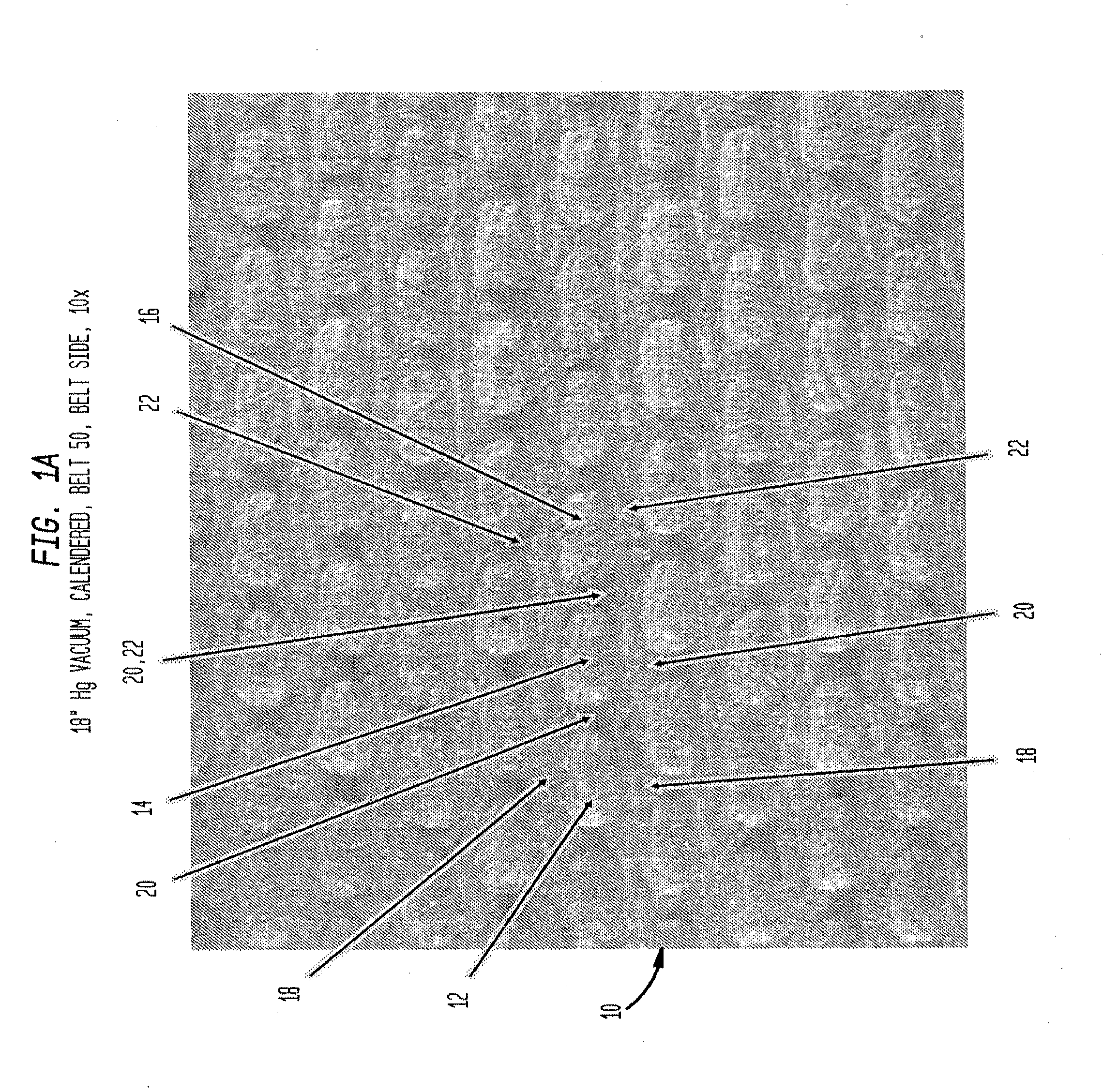Methods of Making a Belt-Creped Absorbent Cellulosic Sheet Prepared with a Perforated Polymeric Belt
a technology of absorbent cellulosic sheet and perforated polymeric belt, which is applied in the directions of non-fibrous pulp addition, patterned paper, transportation and packaging, etc., can solve the problems of insufficient water present to provide sufficient reformation, web has too little cohesion to retain, etc., and achieves high local basis weight, and high roll firmness
- Summary
- Abstract
- Description
- Claims
- Application Information
AI Technical Summary
Benefits of technology
Problems solved by technology
Method used
Image
Examples
examples 1-12
[0240]In Examples 1-4, belt 50, as shown in FIGS. 4-7, was used and a 50% eucalyptus, 50% northern softwood blended tissue furnish was employed. FIGS. 39-40C are X-ray tomography sections of a dome of sheet prepared in accordance with Example 3 in which FIG. 39 is a plan view of a section of the dome while FIGS. 40A, 40B and 40C illustrate sections taken along the lines indicated in FIG. 39. In each of FIGS. 40A, 40B and 40C, it can be observed that upwardly and inwardly projecting regions of the leading edge of the dome are highly consolidated.
[0241]In Examples 5-8, a belt similar to belt 100, but with fewer perforations was used and a 20% eucalyptus, 80% northern softwood blended towel furnish was employed.
[0242]In Examples 9 and 10, a belt similar to belt 100, but with fewer perforations, was used and an 80% eucalyptus, 20% northern softwood layered tissue furnish was employed.
[0243]In Examples 11 and 12, belt 100 was used and a 60% eucalyptus, 40% northern softwood layered tissu...
examples 13-19
[0320]In order to quantify the results demonstrated by the photomicrographs and profiles presented supra, a set of more detailed examinations was conducted on several of the previously examined sheets, as set forth along with a prior art fabric creped sheet and a competitive TAD towel as described in Table 8.
TABLE 8Basis WeightCaliper (Ave.)Example #Identification(Ave.) g / m2μFigs.13W01328.1107.6 25 A-D1419682-GP28.059.3—151968028.871.226 A-F161968328.149.1—181967629.4—27 A-G19Bounty 2 ply28 A-G
[0321]More specifically, to quantitatively demonstrate the microstructure of sheets prepared according to the present invention in comparison to the prior art fabric creped sheets, as well as to the commercially available TAD toweling, formation and thickness measurements were conducted on each on a detailed scale, so that density could be calculated for each location in the sheet on a scale commensurate with the scale of the structure being imposed on the sheets by the belt-creping process. T...
examples 20-25
[0330]Samples of toweling intended for a center-pull application were prepared from furnishes as described in Table 10, which also includes data for TAD towel currently used for that application, as well as the properties thereof along with comparable data for a control towel currently sold for that application produced by fabric creping technology, and an EPA “compliant” towel for the same applications having sufficient post consumer fiber content to meet or to exceed EPA Comprehensive Procurement Guidelines. The TAD towel is a product produced by a TAD technology that is also sold for that application. Of these, the toweling identified as 22624 is considered to be exceptionally suitable for the center-pull application as it exhibits exceptional hand panel softness (as measured by a trained sensory panel) combined with very rapid WAR, and high CD wet tensile. FIGS. 29A-29F are scanning electromicrographs of the surfaces of the 22624 toweling, while FIGS. 29G and 29H illustrate the ...
PUM
| Property | Measurement | Unit |
|---|---|---|
| thickness | aaaaa | aaaaa |
| distance | aaaaa | aaaaa |
| distance | aaaaa | aaaaa |
Abstract
Description
Claims
Application Information
 Login to View More
Login to View More - R&D
- Intellectual Property
- Life Sciences
- Materials
- Tech Scout
- Unparalleled Data Quality
- Higher Quality Content
- 60% Fewer Hallucinations
Browse by: Latest US Patents, China's latest patents, Technical Efficacy Thesaurus, Application Domain, Technology Topic, Popular Technical Reports.
© 2025 PatSnap. All rights reserved.Legal|Privacy policy|Modern Slavery Act Transparency Statement|Sitemap|About US| Contact US: help@patsnap.com



